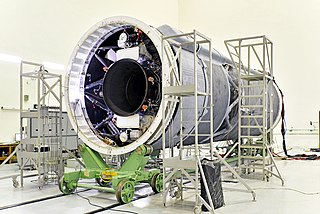
The Indian National Satellite SystemINSAT, is a series of multipurpose geostationary satellites launched by ISRO to satisfy telecommunications, broadcasting, meteorology, and search and rescue operations. Commissioned in 1983, INSAT is the largest domestic communication system in the Indo-Pacific Region. It is a joint venture of the Department of Space, Department of Telecommunications, India Meteorological Department, All India Radio and Doordarshan. The overall coordination and management of INSAT system rests with the Secretary-level INSAT Coordination Committee.

Geosynchronous Satellite Launch Vehicle (GSLV) is a class of expendable launch systems operated by the Indian Space Research Organisation (ISRO). GSLV has been used in fifteen launches since 2001.
GSAT-3, also known as EDUSAT, was a communications satellite which was launched on 20 September 2004 by the Indian Space Research Organisation. EDUSAT is the first Indian satellite built exclusively to serve the educational sector. It is mainly intended to meet the demand for an interactive satellite-based distance education system for the country.

The GSAT satellites are India's indigenously developed communications satellites, used for digital audio, data and video broadcasting. As of 5 December 2018, 20 GSAT satellites of ISRO have been launched out of which 14 satellites are in service.

Satish Dhawan Space Centre – SDSC, is the primary spaceport of the Indian Space Research Organisation (ISRO), located in Sriharikota, Andhra Pradesh.

The Liquid Propulsion Systems Centre (LPSC),Thiruvananthapuram is a research and development centre functioning under Indian Space Research Organisation (ISRO). It has two units located at Valiamala, in Thiruvananthapuram of Kerala, and Bengaluru of Karnataka. LPSC is augmented by ISRO Propulsion Complex at Mahendragiri of Tamil Nadu.

The Launch Vehicle Mark-3 or LVM3 is a three-stage medium-lift launch vehicle developed by the Indian Space Research Organisation (ISRO). Primarily designed to launch communication satellites into geostationary orbit, it is also due to launch crewed missions under the Indian Human Spaceflight Programme. LVM3 has a higher payload capacity than its predecessor, GSLV.

GSAT-4, also known as HealthSat, was an experimental communication and navigation satellite launched in April 2010 by the Indian Space Research Organisation on the maiden flight of the Geosynchronous Satellite Launch Vehicle Mk.II rocket. It failed to reach orbit after the rocket's third stage malfunctioned. The third stage was the first Indian-built cryogenic-fuelled upper stage, and was making its first flight. The ISRO suspects that the failure was caused by the third stage not igniting.

The Vikas is a family of hypergolic liquid fuelled rocket engines conceptualized and designed by the Liquid Propulsion Systems Centre in the 1970s. The design was based on the licensed version of the Viking engine with the chemical pressurisation system. The early production Vikas engines used some imported French components which were later replaced by domestically produced equivalents. It is used in the Polar Satellite Launch Vehicle (PSLV), Geosynchronous Satellite Launch Vehicle (GSLV) and LVM3 for space launch use.

The CE-20 is a cryogenic rocket engine developed by the Liquid Propulsion Systems Centre (LPSC), a subsidiary of the Indian Space Research Organisation (ISRO). It has been developed to power the upper stage of the LVM3. It is the first Indian cryogenic engine to feature a gas-generator cycle. The high thrust cryogenic engine is the most powerful upper stage cryogenic engine in operational service.

The CE-7.5 is a cryogenic rocket engine developed by the Indian Space Research Organisation to power the upper stage of its GSLV Mk-2 launch vehicle. The engine was developed as a part of the Cryogenic Upper Stage Project (CUSP). It replaced the KVD-1 (RD-56) Russian cryogenic engine that powered the upper stage of GSLV Mk-1.
GSAT-5P, or GSAT-5 Prime, was an Indian communications satellite which was lost in a launch failure in December 2010. Part of the Indian National Satellite System, it was intended to operate in geosynchronous orbit as a replacement for INSAT-3E.
KVD-1 was an upper stage LOX/LH2 cryogenic engine developed by the Isayev Design Bureau (now KB KhIMMASH) of Russia in the early 1960s. It is a modified version of the RD-56, developed for a never-completed cryogenic upper stage of the N-1 super-heavy lift rocket, with the goal of enabling crewed lunar missions by the USSR. The KVD-1 produces a thrust of 7.5 tonnes.
The ISRO Propulsion Complex (IPRC), located at Mahendragiri of Tamil Nadu, is an Indian Space Research Organisation (ISRO) centre involved in testing, assembling, and integrating propulsion systems and stages that are developed at ISRO's Liquid Propulsion Systems Centres. Formerly, IPRC was known as LPSC, Mahendragiri, functioning under LPSC. It was elevated as an independent centre and renamed as IPRC with effect from 1 February 2014.

GSAT-7A is an advanced military communications satellite meant primarily for the Indian Air Force with Indian Army using 30% of capacity.

GSAT-6A was a communication satellite launched by the Indian Space Research Organisation (ISRO) It featured a 6-metre (20 ft) unfurlable S-band antenna similar to the one used on GSAT-6. Around 17 minutes after lift-off, the three stage GSLV Mk.II rocket flying on GSLV F08 mission successfully injected the satellite into a geosynchronous transfer orbit. Due to power failure during its orbit raising burns the communication was lost with GSAT-6A before it could reach its final circular geostationary orbit (GSO).

GSAT-29 is a high-throughput communication satellite developed by the Indian Space Research Organisation (ISRO). The mission aims at providing high-speed bandwidth to Village Resource Centres (VRC) in rural areas. The two Ku and Ka operational payloads will provide communication services to Jammu and Kashmir and Northeast India under Digital India programme. At the time of launch GSAT-29 was the heaviest satellite, weighing 3,423 kg (7,546 lb), that was placed in orbit by an Indian launch vehicle. Approved cost of GSAT-29 is ₹175.63 crore (US$22 million).

The GSLV F12 is the 15th flight of the GSLV and the 9th flight of Mk2 variant using indigenous Cryogenic engine.













